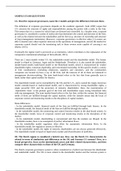SAMPLE EXAM QUESTIONS
1A. Describe corporate governance, name the 2 models and give the differences between them.
The definition of corporate governance depends on the academic approach. Aoki (2001) argue that
CG concerns the structure of rights and responsibilities among the parties with a stake in the firm.
This means that it is a system by which firms are directed and controlled. In a broader term, corporate
governance is considered a system of (soft) rules that determines the control and direction of the firm,
as well as the relation between the stakeholders and the firm (e.g. structure of ownership and structure
of (top) management institutions). Moreover, corporate governance is effective when: (1) owners are
able to monitor and, when required, intervene in the operations of management, and (2) the market for
corporate control should vest the monitoring task in those owners most capable of carrying it out
(Haxhi, 2015).
Eventually the regime itself is perceived as an institution, which contributes to the explanation of the
comparative institutional advantage of firms (Haxhi, 2015).
There are 2 main models within CG: the stakeholder model and the shareholder model. The former
model is related to Germany, Japan and the Netherlands. Therefore it is also named the stakeholder,
insider-based model, bank-based model or the Rhineland model, which is characterized by weaker
shareholder rights, consensus leadership, and concentrated ownership. In this specific model, a variety
of firm constituencies (including employees, suppliers and customers, and the communities
companies are located in) have a say in the firm, and the interests of all of them are balanced in
management decision-making. The term bank-based refers to the fact that firms generally turn to
banks rather than capital markets for finance.
The shareholder model can be exemplified by the UK and the U.S., and is named the Anglo-American
model, outsider-based or market-based model, and is characterized by strong shareholder rights, a
single powerful CEO and the protection of minority shareholders. Here, the maximization of
‘shareholder value’ is the primary goal of the firm and shareholders enjoy strong formalized links
with top management. The term market-based refers to the fact that, within the system, the financial
needs of firms are fulfilled through the capital markets, while the outsider means that the locus of
corporate control and monitoring resides in the disciplines of capital markets.
Main differences:
- In the stakeholder model, financial needs of the firm are fulfilled through bank finance. In the
shareholder model, the financial needs of the firm are fulfilled through the market.
- In the stakeholder model, the monitoring and control function resides in the dual-board system. In
the shareholder model, locus of corporate control and monitoring resides in the disciplines of the
market.
- In the stakeholder model, shareholding is concentrated and thus the markets are illiquid. In the
shareholder market, there is an assumption of perfect information flows.
- In the stakeholder model, regulators often allow for asymmetric information flows. In the
shareholder model, the regulatory system is effective.
- In the stakeholder model, the rights of minority shareholders are not always protected effectively.
The shareholder model is based on liquid stock market and diversification of portfolios.
1B. The Dutch regime is considered a hybrid case. How can the Dutch CG characteristics be
related in terms of similarities and differences to the UK and German CG systems? First, in a
broad perspective, focus on the (institutional) actors and their related characteristics, and then
compare these characteristics to those of the UK and Germany.
The Dutch corporate governance system is often considered as a hybrid case between the shareholder
and stakeholder model. The UK is more related to the shareholder market and the German system is




